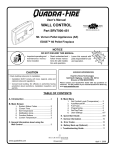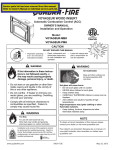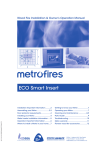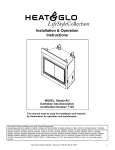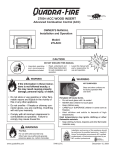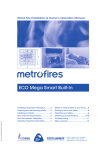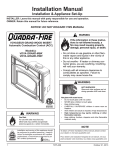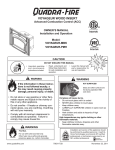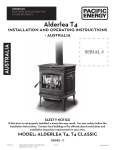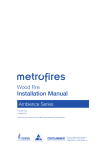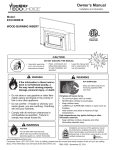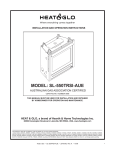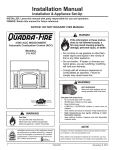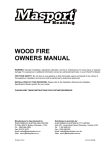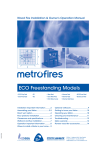Download United States Stove 30A Owner`s manual
Transcript
R VOYAGEUR GRAND INSERT Automatic Combustion Control (ACC) OWNER’S MANUAL Installation and Operations Model: GRAND-MBK-AU INSTALLATIONS TO COMPLY WITH AS/NZS2918:2001 AND WILL REQUIRE A BUILDING CONSENT IMPORTANT: Read all instructions carefully before starting installation. Failure to follow these instructions may result in a fire hazard and will void the warranty. • Fig. 3,4,5,6, 7 and Table 1,2,3,4 relate to installations with tested flue systems; as per AS/NZS 2918:2001 - Appendix F, with a ceiling angle between 0° - 30° inclusive. • For installations with a ceiling angle greater than 30°, refer to Fig. 18.1, 21.1 & 21.2 and AS/NZS 2918:2001 4.6.3(b) • Ceiling Plate may vary in size depending on ceiling angle. Please specify ceiling pitch prior to ordering the ceiling plate. • Quadra-Fire Voyageur Grand ACC wood burner’s are tested and approved to the N.Z. National Environmental Standards; GRAND-MBK-AU Voyageur Grand Insert Hardwood Certified Particulate Emissions = 2.0 g/kg Space Heating Efficiency = 62.8% Page 1 7075-205 April 29, 2013 R Voyageur Grand Hearth & Home Technologies welcomes you to our tradition of excellence! In choosing a Quadra-Fire appliance, you have our assurance of commitment to quality, durability, and performance. This commitment begins with our research of the market, including ‘Voice of the Customer’ contacts, ensuring we make products that will satisfy your needs. Our Research and Development facility then employs the world’s most advanced technology to achieve the optimum operation of our stoves, inserts and fireplaces. And yet we are old-fashioned when it comes to craftsmanship. Each unit is meticulously fabricated and surfaces are hand-finished for lasting beauty and enjoyment. Our pledge to quality is completed as each model undergoes a quality control inspection. We wish you and your family many years of enjoyment in the warmth and comfort of your hearth appliance. Thank you for choosing Quadra-Fire. VOYAGEUR GRAND OVERALL AVERAGE EFFICIENCY BURNING HARDWOOD (WHEN TESTED IN ACCORDANCE TO AS/NZS 4012) 62.8% AVERAGE PARTICULATE EMISSION FACTOR BURNING HARDWOOD (WHEN TESTED IN ACCORDANCE TO AS/NZS 4013) 2.0 g/kg MAXIMUM AVERAGE HEAT OUTPUT BURNING HARDWOOD 9.3 kw APPROVED FUEL BURN ONLY HARDWOOD WITH A MOISTURE CONTENT LESS THAN 25% (dry basis). WETBACK - ALL MODELS MANUFACTURED BY Wetbacks are NOT an approved option and must not be fitted. NOTE: Performance may vary from test values depending on actual operating conditions. INSTALLATION DATE R VOYAGEUR GRAND INSERT This appliance has been TESTED TO AS/NZS4013 for Hardwood by VIPAC LTD. Report # 30A-13-0025-TRP-331382-0 Date tested: March 2013 Serial No. 007057 Mfg by: 1445 N. Highway, Colville, WA 99114 www.quadrafire.com U.S. ENVIRONMENTAL PROTECTION AGENCY - Export stove. May not be operated within the United States JAN FEB MAR APR MAY JUN JUL AUG SEP OCT NOV DEC 2013 2014 2015 DO NOT REMOVE THIS LABEL Made in U.S.A. of US and imported parts. 7075-206 Page 2 7075-205 April 29, 2013 Voyageur Grand R Safety Alert Key: • DANGER! Indicates a hazardous situation which, if not avoided will result in death or serious injury. • WARNING! Indicates a hazardous situation which, if not avoided may result in death or serious injury. • CAUTION! Indicates a hazardous situation which, if not avoided, may result in minor or moderate injury. • NOTICE: Indicates practices which may cause damage to the appliance or to property. TABLE OF CONTENTS Congratulations................................................................2 Serial Number Label.........................................................2 User’s Guide Section 1: Operating Instructions A. Quick Start Guide...............................................4 B. Automatic Combustion Control (ACC)...............5 C. Air Controls........................................................5 D. Burn Rates and Operating Efficiency.................5 E. Blower Control Box Snap Disc Operations........5 F. Blower Operating Instructions............................5 Section 2: Maintenance & Service A. Disposal of Ashes..............................................7 B. Chimney and Chimney Connector Inspection/Cleaning...........................................7 C. Appliance Inspection - Routine..........................7 D. Cleaning Plated Services...................................7 E. Glass Cleaning...................................................8 F.Inspect Firebrick & Replacement Instructions....8 G. Quick Reference Maitenance Guide..................9 H. Trouble Shoot Guide..........................................10 Section 3: Service Parts Replacement A. B. C. D. E. F. G. Glass Replacement............................................11 Snap Disc Replacement....................................11 Wiring Diagram..................................................11 Blower Replacement..........................................12 Door Handle Assembly......................................13 Baffle & Ceramic Blanket Removal....................13 Tube Channel Assembly Replacement..............14 Installer’s Guide Section 4: Getting Started A. B. C. Tools and Supplies Needed...............................15 Fire Safety..........................................................15 Inspect Appliance and Components and Pre-Burn Checklist......................................15 Section 5: Dimensions and Clearances A. Appliance Dimensions.......................................16 B. Clearances to Combustibles (UL and ULC) and Hearth Protection Requirements.................17 C. Alternate Floor Protection Calculation...............18 Section 6: Chimney Systems A. B. C. D. E. F. G. Venting Systems................................................19 Inspections.........................................................19 Larger Chimneys................................................19 Masonry Chimney..............................................19 Prefabricated Metal Chimney.............................19 Installation into a Masonry Fireplace.................20 Installation into a Factory Built Fireplace...........20 Section 7: Appliance Set-up A. B. C. D. E. F. G. H. I. Outside Air Installation.......................................22 Optional Elbow Flue Adapter Installation...........23 Securing Stove Pipe/Liner to Flue Collar...........23 Leveling Legs.....................................................23 Securing Appliance to Stove Pipe/Liner.............24 Standard Surround & Trim Installation...............24 Standard Surround & Cast Trim,........................25 All Cast Surround...............................................26 Blower Cord Installation - Left Side....................26 Section 8: Reference Materials A.Warnings............................................................29 B. Warranty Policy..................................................30 C. Contact Information............................................32 April 29, 2013 7075-205 Page 3 R Voyageur Grand User’s Guide 1 Operating Instructions A. Quick Start Guide Note: These are generic drawings and may not represent your specific model. FIRST FIRE ITEMS NEEDED: LOW START-UP AIR ADD NEWSPAPER LOAD WOOD OPEN AIR CONTROLS HIGH 10 Pieces of Newspaper, 10-20 Pieces of Dry Kindling and a Few Pieces of Dry Split Wood. BURN RATE Upper right corner Lower right corner Push In and then Pull Out 2 1 ADD KINDLING 3 WARNING! Risk Of Fire DO NOT LEAVE UNATTENDED During startup, if additional draft is needed, allow the door to remain open approximately1/2 inch. Once the draft is established, close and securely latch the door to prevent: • Spillage of smoke, flame and carbon monoxide • Spillage of sparks, coals and logs • Over-firing LIGHT THE PAPER DO NOT leave the stove unattended with the door open 4 ADD MORE WOOD & SECURELY LATCH THE DOOR 5 REDUCE AIR CONTROL Set to desired heat output HIGH LOW The stove is ready for normal operation. BURN RATE CONTROL Upper Right Corner 6 Page 4 7 7075-205 April 29, 2013 Voyageur Grand R B. Automatic Combustion Control (ACC) Typically, when you build a fire, you open the air controls fully and monitor the fire to prevent it from going into an overfire situation and/or burning your wood up too quickly before you shut down the air controls to the desired burn rate. When using the Automatic Combustion Control (ACC) system, you do not have to continually monitor the fire. Once you set the ACC system it will control the fire for you. Follow the instructions below to learn how to operate your stove with ease. C. Air Controls D. Burn Rates and Operating Efficiency For maximum operating efficiency 1. Burn dry, well-seasoned wood. 2. Follow these burn rate instructions below and refer to Figure 5.1. *NOTE: These are guidelines. Actual settings may vary with type of wood, chimney draft, altitude and other variables. E. Blower Control Box & Snap Disc Operating Instructions 1. The blower will turn on/off automatically when set to AUTO. Figure 6.1 on page 6. 1. Start-Up Air Control The function of the Start-Up Air Control is to activate the Automatic Combustion Control system (ACC). • Push the Start-Up Air Control all the way back until it stops and then pull forward to the front of the appliance until it stops. Figure 5.1. • The air channel opens and allows air to enter the front of the appliance for approximately 20-25 minutes. • The air channel gradually shuts down until it is completely closed at the end of the 20-25 minutes. • The fire is now controlled by the air supplied by the Burn Rate Air Control. Figure 5.1. • This function should be performed each time you reload the appliance. 2. Burn Rate Air Control • The air supply enters at the upper front of the firebox, near the top of the glass door. • This preheated air supplies the necessary fresh oxygen to mix with the unburned gases, helping to create the second, third and fourth combustion process. • This air is regulated by the Burn Rate Air Control. • There are four settings High, Medium-High, Medium-Low and Low. • When the control is raised all the way up it is on the High setting and when pushed all the down it is on the Low setting. HIGH Burn Rate Control LOW 2. When set to MANUAL, the fan will turn on/off only when you turn it on or off. This setting over-rides the internal snap disc. 3. Swing the grille downward to expose the blower controls. Adjust the speed of the fan by turning the HIGH/LOW knob to the desired setting. F. Blower Operating Instructions 1.Initial (cold) startup: Open both controls fully by raising the Burn Rate Air Control all the way up until it stops and PUSH the Start-up Air Control back until it stops. The blower tends to cool the appliance. Leave the blower off until the burn is well established, i.e., 30 minutes. 2.High Burn Setting: Both controls are open. Burn Rate Air Control is pulled up and the Start-up Air Control is fully pushed in. Blower may remain on. 3. Medium-High Burn Setting*: Burn Rate Air Control is closed then opened to 1 inch to fully open (pull up). Blower may remain on. 4. Medium-Low Burn Setting*: Burn Rate Air Control is closed then opened to 1/4 inch to 1/2 inch (pull up). Leave the blower off until the burn is well established, i.e., 30 minutes. 5. Low Burn Setting*: Burn Rate Air Control is closed (down position). Leave the blower off until the burn is well established, i.e., 30 minutes. *NOTE: For burn settings 3 to 5 the Start-up Air Control needs to be pushed in (Open) then pulled forward to activate the Automatic Combustion Control (ACC). NOTE: For maximum efficiency and lowest emissions, when operating the blower in either the automatic or manual setting for the low and medium low burn settings leave the blower off until the burn is well established, i.e., 30 minutes. ACC Start-up Air Control To activate: Push back until it stops and then pull forward until it stops Figure 5.1 Start-up and Burn Rate Air Controls April 29, 2013 7075-205 Page 5 R Voyageur Grand 6. The blower is equipped with a rheostat (speed control). The highest blower speed is obtained by turning the rheostat on, then adjusting back towards “OFF” as far as possible without turning the blower off. For a low blower speed, turn the control knob clockwise as far as possible Blower Controls Under Ash Lip MANUAL: overrides the internal snap disc AUTO: Fan with turn ON/OFF automatically and is controlled by the internal Snap Disc Figure 15.1 6.1 NOTICE! Do NOT operate a circulating fan within close proximity, approximately 4 ft (1.2m), of appliance •Can reverse air flow, blowing hot air into appliance cavity. •Can damage appliance blower due to overheating. Page 6 7075-205 April 29, 2013 Voyageur Grand R 2 Maitenance & Service A. Disposal of Ashes • Frequency: When ash reaches the top of the brick covers (should not spill over covers). Leave 1/4 inch (6mm) of ash in the bottom of the firebox. • By: Homeowner WARNING! Risk of Fire! Ashes could contain hot embers. • Place ashes in a metal container with a tight-fitting lid. • The closed container should be placed on a noncombustible floor or on the ground, well away from all combustible materials, pending final disposal. • If the ashes are disposed of by burial in soil or otherwise locally dispersed, they should be retained in the closed container until all cinders have thoroughly cooled • The creosote vapors condense in the relatively cool chimney flue of a slow-burning fire. • As a result, creosote residue accumulates on the flue lining. When ignited this creosote makes an extremely hot fire. • The chimney and chimney connector shall be inspected every two months during the heating season to determine when a creosote buildup has occurred. • When creosote has accumulated it shall be removed to reduce the risk of a chimney fire. C. Appliance Inspection - Routine B. Chimney and Chimney Connector Inspection/Cleaning • Frequency: Every 2 months during heating season or as recommended by a certified chimney sweep; more frequently if chimney exceeds or is under 14-16 feet (4.3 to 4.8m) measured from bottom of appliance. • By: Certified chimney sweep • Remove all ash from the firebox and extinguish all hot embers before disposal. • Allow the appliance to cool completely. • If your type of installation involves a full reline of the chimney, it will be necessary to either remove the baffle from the insert, or remove the insert from the fireplace and disconnect the vent prior to cleaning the chimney. Refer to page 23 in this manual for instructions on Baffle Removal. • If your type of installation is direct connect within a masonry chimney, the insert will need to be pulled out from the fireplace and disconnected from the flue prior to cleaning the chimney. • The creosote or soot should be removed with a brush specifically designed for the type of chimney in use. • Clean out fallen ashes from the firebox. • It is also recommended that before each heating season the entire system be professionally inspected, cleaned and repaired if necessary. • Frequency: Every 2 months at the same time the chimney and chimney connector are inspected. • By: Homeowner Check for: • Cracks in glass • Door handle - smooth cam operation • Baffle and ceramic blanket correct placement • Baffle for warpage • Firebrick for cracks, broken or crumbly • Door gasket. (Dollar bill test). Place a dollar bill between the stove and the door and then shut the door. If you can pull the dollar bill out, replace the door gasket. • Glass frame for loose screws D. Cleaning Plated Surfaces • Frequency: As desired • By: Homeowner • Clean all the fingerprints and oils from plated surfaces BEFORE firing the appliance for the first time. • If not cleaned properly before lighting your first fire, the oils can cause permanent markings on the plating. • After the plating is cured, the oils will not affect the finish and little maintenance is required. • Wipe clean as needed. WARNING! Risk of Fire! Do not use chimney cleaners or flame colorants in your appliance. It will corrode your pipe. April 29, 2013 Creosote - Formation and Need for Removal • When wood is burned slowly, it produces tar and other organic vapors, which combine with expelled moisture to form creosote. CAUTION! Do not use polishes with abrasives. It will scratch plated surfaces. 7075-205 Page 7 R Voyageur Grand F. Inspect Firebrick & Replacement Instructions E. Glass Cleaning • Frequency: As desired • Frequency: After each ash removal • By: Homeowner • Clean glass with a non-abrasive glass cleaner. Abrasive cleaners may scratch and cause glass to crack. • By: Homeowner • If the deposits on the glass are not very heavy, normal glass cleaners work well. Heavier deposits may be removed by using a damp cloth dipped in wood ashes or by using a commercially available oven cleaner. • After using an oven cleaner, it is advisable to remove any residue with a glass cleaner or soap and water. Oven cleaner left on during the next firing can permanently stain the glass and damage the finish on plated metal surfaces. • A portion of the combustion air entering the firebox is deflected down over the inside of the door glass. • This air flow “washes” the glass, helping to keep smoke from adhering to its surface. • When operated at a low burn rate, less air will be flowing over the glass and the smoky, relatively cool condition of a low fire will cause the glass to become coated. • Operating the appliance with the Burn Rate Air Control and Start-Up Air Control all the way open for 15-20 minutes should remove the built up coating. CAUTION! Handle glass assembly with care. Glass is breakable. Replace the firebrick if they become crumbly and/or if there is a 1/4 inch (6.35mm) gap between the bricks. The firebox is lined with firebrick, which has exceptional insulating properties. Do not use a grate; simply build a fire on the firebox floor. Do not operate appliance without firebrick. 1. After the coals have completely cooled, remove all old brick and ash from unit and vacuum firebox. 2. Remove new brick set from box and lay out to the diagram shown in the instructions that come with the replacement brick set. 3. Lay bottom bricks in unit. 4. Install rear bricks on the top of the bottom bricks. 5. Install side bricks. Slide top of brick under clips on side of firebox and push the bottom of the brick until it is flush with the side of the unit. Use Part 832-0550 when ordering individual brick. Provide brick dimension or copy the page in the service parts list, mark the desired brick and take it to your authorized dealer. • Avoid striking, scratching or slamming glass • Avoid abrasive cleaners • Do not clean glass while it is hot Page 8 7075-205 April 29, 2013 Voyageur Grand R G. Quick Reference Maintenance Guide CAUTION! Allow the appliance to completely cool down before performing any cleaning or maintenance. Baffle & Blanket Blanket Baffle Optional Blower Chimney System Frequency Start the first inspection after the first 2 months of use, or if performance changes, and adjust your schedule accordingly. Maintenance is required for safe operation and must be performed to maintain your warranty. Task MONTHLY or After Every Cord of Wood Baffle and blanket placement is critical to heat output, efficiency and overall life of the unit. Make sure the baffle is pushed all of the way to the back of the firebox and the blanket is laying flat. Inspect baffle for cracks. YEARLY or After Every 4 Cords of Wood Vacuum the blower impellers. EVERY 2 MONTHS or After Every 4 Cords of Wood The chimney and chimney cap must be inspected for soot and creosote every two months during the burn season or more frequency if chimney exceeds or is under 14-16 ft (4.3m-4.8m) measured from bottom of appliance. This will prevent pipe blockage, poor draft, and chimney fires. Always burn dry wood to help prevent cap blockage and creosote build-up. Firebrick & Ash Removal Door & Glass Assemblies Door Handle Latch Cam Spacing Washers WEEKLY or After Every 25 Loads of Wood WEEKLY or After Every 25 Loads of Wood WEEKLY or After Every 25 Loads of Wood Ashes must be cool before you can dispose of the ashes in a non-combustible container. Firebrick is designed to protect your firebox. After ashes are removed, inspect the firebrick and replace firebricks that are crumbling, cracked or broken. Keep door and glass gasket in good shape to maintain good burn times on a low burn setting. To test: place a dollar bill between the stove and door and then shut the door. If you can pull the dollar out, remove one washer from door handle behind latch cam and try again. If you can still pull it out, replace the door gasket. Check the glass frame for loose screws to prevent air leakage. Check glass for cracks. Check the door latch for proper adjustment. This is very important especially after the door rope has formed to the stove face. Check door handle for smooth cam operation. Note: These are generic drawings and may not represent your specific model. April 29, 2013 7075-205 Page 9 R Voyageur Grand H. Troubleshooting Guide With proper installation, operation, and maintenance your woodstove will provide years of trouble-free service. If you do experience a problem, this troubleshooting guide will assist you or a qualified service person in the diagnosis of a problem and the corrective action to be taken. Start Fire Problems Possible Cause Solution Can not get fire started Excessive smoke or spillage Burns too slowly Not enough heat output Not enough kindling/paper or no kindling/paper Use dry kindling, more paper. Arrange kindling & wood for air movement. Check for restricted termination cap Check for blockage of outside air kit (if installed). Check for flue blockage. Not enough air for fire to ignite Pre-warm flue before starting fire (refer to Building a Fire Section). Check for adequate vent height (refer to Chimney Height Section). Open window below the appliance towards the wind. Wood condition is too wet, too large Use dry, seasoned wood (refer to Seasoned Wood Section). Bed of coals not established before adding wood Start with paper & kindling to establish bed of coals (refer to Building a Fire Section). Flue blockage such as birds’ nests or leaves in termination cap Have chimney inspected for creosote and cleaned by a certified chimney sweep. Down draft or negative pressure Competition with exhaust devices Do not use exhaust fans during start-up (refer to Negative Pressure Section). Fire burns too fast Mix in hardwood. Extremely dry or soft wood Mix in less seasoned wood after fire is established (refer to Wood Fuel Section). Check for correct vent height; too much vertical height creates overdrafting. Overdrafting Page 10 Open window below the appliance towards the wind. Check location of vent termination (refer to Chimney Termination Requirement Section). 7075-205 April 29, 2013 Voyageur Grand R 3 Service Parts Replacement UNPLUG APPLICE FROM ANY POWER SOURCE BEFORE REPLACING ANY COMPONENTS A. Glass Replacement (Replace with 5mm ceramic glass only) 1. Ensure that the fire is out and the appliance is cool to the touch. 2. Protect a table or counter top with padding or towels. Protect your hands and wear gloves to prevent injury. 3. Remove the door with the broken glass by lifting the door up and off of the hinges. 4. Lay door face down on a table or counter making sure the handle hangs over the edge so the door lays flat, on a soft surface. 5. Remove the screws from each glass retainer and remove the glass. (If screws are difficult to remove, soak with penetrating oil first). B. Snap Disc Replacement (Cont’d) 2. Remove the 2 screws from the blower access assembly and slide assembly away from the appliance 3. Locate the snap disc bracket assembly behind the blower controls on the right side under the ash lip. Figure 8.1 4. Remove the 2 mounting screws in the blower control bracket and slide assembly towards you. 5. Using a Phillips head screw driver, remove the 2 screws from the snap disc and lift the snap disc off of the mounting bracket. Disconect the wires and replace with new snap disc and re-connect the wires. 6. Slide the blower control bracket back into position and secure with the 2 mounting screws. 6. Center the glass with edges evenly overlapping the opening in the door, (i.e. same space top and bottom, left and right sides). 7. Replace the glass retainers. Be careful not to cross thread the screws. Blower Controls & Snap Disc Under Ash Lip 8. Tighten each retainer just a few turns until each is secured. Check again for centering of glass in door frame. Continue to tighten each retainer alternately, a few turns at a time, until the glass is secure. DO NOT OVERTIGHTEN - can cause glass to break. Snap Disc 9. Replace the door on the appliance. WARNING! Risk of Fire or Injury! Use only glass that is specified in the manual, DO NOT replace with any other material. Glass breakage will occur. Figure 7.1 Snap Disc Location CAUTION! C. Wiring Diagram Handle glass with care. • Inspect the gasket to ensure it is undamaged. • Do NOT strike, slam or scratch glass. • Do NOT operate appliance with glass & door assembly removed. • Do NOT operate with glass cracked, broken or scratched. Blower Black Quadra-Fire appliances are equipped with ceramic super heat-resistant glass, which can only be broken by impact or misuse. Red White Snap Disc Black White Black Power Cord B. Snap Disc Replacement 1. The grille on the blower access assembly is hinged. Swing the grille downward to expose the 2 screws. Figure 9.1 on page 9. April 29, 2013 Switch Rheostat Figure 7.2 Snap Disc Location 7075-205 Page 11 R Voyageur Grand D. Blower Replacement 1. The grille on the blower access assembly is hinged. Swing the grille downward to expose the 2 screws. Figure 8.1 2. Remove the 2 screws from the blower access assembly and slide assembly away from the appliance. 3. Disconnect the wires from the blower. CAUTION Shock Risk • Do NOT remove grounding prong from plug. • Plug directly into properly grounded 3 prong receptacle. • Route cord away from appliance. • Do NOT route cord under or in front of appliance. 4. Remove the 2 screws from the hold down bracket and pull the blower and bracket forward. 5. Remove the blower from the hold down bracket. 6. Remove the protection guards from each end of the blower. 7. Re-install in reverse order. Be certain that the hold down bracket’s screws are completely seated in the gromments. Insert the locating tab in the hold down bracket into the placement slot. WARNING Fire Risk Do NOT allow hot coals or embers to overflow ash lip • May melt protective wire coating on fan power cord causing electrical short, fire or injury CAUTION! Unplug appliance from power source before replacing any components. Placement Slot Blower Access Assembly Grille hinges downward Remove Screws & Pull Access Assembly away from Insert Figure 8.1 Page 12 Hold Down Bracket Remove Screws from Hold Down Bracket and Pull Forward 7075-205 April 29, 2013 Voyageur Grand R E. Door Handle Assembly F. Baffle & Ceramic Blanket Removal 1. Install washer on door handle shaft. 1. Remove all ash from the firebox, and extinguish all hot embers before disposal into a metal container. 2. Slide door handle through door. 3. Install additional washer(s) as shown in Figure 9.1. 4. Install key in groove. 5. Align groove in latch cam with key; slide latch cam over shaft 6. Install locknut but do not overtighten, the handle needs to move smoothly. 7. Install handle turning in a counter-clockwise motion to desired location on door handle rod. Figure 9.1 CAUTION! Do not overtighten lock nut. The door handle needs to move smoothly. Latch Cam 2. It is easier to remove both baffle boards and ceramic blanket after the tube channel assembly has been partially disassembled and the right side lowered. It is not necessary to completely remove the tube channel assembly. 3. Once the baffle protection cover has been removed, pull the baffle boards and ceramic blanket forward about 1 inch (25mm) and then overlap the baffles about 1-2 inches (2551mm). Figure 9.2 4. Slide the tube channel assembly to the left as far as it will go and lower the right side. Remove the baffle boards and ceramic blanket together. Figure 9.3 4. Re-install in reverse order. Be sure the baffle boards and ceramic blanket are in their proper positions. Door Cross Section Door Handle Shaft Ceramic Blanket Locknut Spacing Washers Baffle Boards Overlapping Square Key Fiber Handle Figure 9.1 Figure 9.2 Slide Tube Channel to the Left and Lower Right Side Figure 9.3 April 29, 2013 7075-205 Page 13 R Voyageur Grand G. Tube Channel Assembly Replacement Removing Tube Channel Assembly Bend Back Tabs 1.Remove the 3 right side bricks. 2.Remove the baffle protection channel by bending back the tabs using needle nose pliers located at the right and left side of the protection cover. Lift the cover up slightly and pull toward the front and out of the firebox. Figure 10.1 Baffle Protection Channel 3.Locate the 2 channel nuts and two bolts inside of chamber and remove using a 7/16 socket wrench. Figure 10.2 Figure 10.1 NOTE:Soak the bolts with penetrating oil for at least 15 minutes before trying to remove them. 4.Slide the tube channel assembly all the way to left until it is off the threads. Drop the right side down, then slide the assembly back to right. Figure 10.3 5.The ceramic blanket and both baffle boards can be removed at the same time you remove the tube channel assembly. Use 7/16 Socket Wrench and Remove Channel Nuts 6.When the tube channel assembly is free of the left side support, rotate clockwise and pull assembly, blanket and baffles out through the front opening. Figure 10.2 7.Re-install in reverse order. Tube Channel Assembly 2 Tube Channel Nuts Ceramic Blanket 2 Baffle Boards Baffle Protection Channel Figure 10.3 Page 14 7075-205 April 29, 2013 Voyageur Grand R 4 Getting Started Installer’s Guide A. Tools And Supplies Needed Pre-Burn Check List Before beginning the installation be sure the following tools and building supplies are available: 1. Place the appliance in a location near the final installation area and follow the procedures below: 2. Open the appliance and remove all the parts and articles packed inside the Component Pack. Inspect all the parts and glass for shipping damage. Contact your dealer if any irregularities are noticed. 7/16 Socket Framing materia Reciprocating saw High temp caulking material l Pliers Gloves Hammer Framing square 3. All safety warnings have been read and followed. Phillips screwdriver Electric drill and bits 4. This Owner’s Manual has been read. Flat blade screwdriver Safety glasses 5. Floor protection requirements have been met. Plumb line Tape measure 6. Venting is properly installed per vent manufacturing instructions. 7. The proper clearances from the appliance and chimney to combustible materials have been met. 8. The masonry chimney is inspected by a professional and is clean, or the factory built metal chimney is installed according to the manufacturer’s instructions and clearances. 9. The chimney meets the required minimum height. 10. All labels have been removed from the glass door. 11. Plated surfaces have been wiped clean, if applicable. 12. A power outlet is available nearby for use of the blower assembly. Level Wire Cutters to remove from pallet 1/2-3/4 in. length, #6 or #8 self-drilling screws Misc. screws and nails B. Fire Safety To provide reasonable fire safety, the following should be given serious consideration: 1. Install at least one smoke detector on each floor of your home to ensure your safety. They should be located away from the heating appliance and close to the sleeping areas. Follow the smoke detector manufacturer’s placement and installation instructions, and be sure to maintain regularly. 2. A conveniently located fire extinguisher to contend with small fires resulting from burning embers. WARNING C.Inspect Appliance and Components • Remove appliance and components from packaging and inspect for damage. • Vent system components and doors are shipped in separate packages. • Report to your dealer any parts damaged in shipment. Fire Risk Inspect appliance and components for damage. Damaged parts may impair safe operation. • Do NOT install damaged components. • Do NOT install incomplete components. • Do NOT install substitute components. Report damaged parts to dealer. • Read all the instructions before starting the installation. Follow these instructions carefully during the installation to ensure maximum safety and benefit. April 29, 2013 7075-205 Page 15 R Voyageur Grand 5 Dimensions and Clearances NOTE: Flue Collar size is 152 mm diameter (ID) A. Appliance Dimensions 32 5/8 (829mm) 23 3/4 (602mm) A 17 15/16 456 mm B 5 (127mm) Figure 12.1 Top View 14 (356mm) Figure 12.2 Front View with Cast Surround A Overall Sizes Part #: DV-4615 B Metal Surround w/Cast Trim-STD 1080 mm 762 mm Metal Surround w/Cast Trim-LRG 1219 mm 864 mm All Cast Surround 1016 mm 762 mm Metal Surround w/Standard Trim-STD 1092 mm 787 mm Metal Surround w/Standard Trim-LRG 1295 mm 2184 mm 25 3/4 (655mm) 14 (356mm) 11 (279mm) 4 (102mm) 15 (382mm) 30° 23 1/2 (597mm) 25 1/2 (648mm) 6 1/16 (154mm) 2 7/8 (73mm) Figure 12.3 - Side View With Optional Flue Adapter Page 16 Figure 12.4 - Side View Without Optional Flue Adapter 7075-205 April 29, 2013 Voyageur Grand R B. Clearances to Combustibles 22 1/2 (572mm) 35 1/4 (896mm) SIDE TRIM (3” max depth) SIDE WALL TOP TRIM (3/4” max depth) 43 (1092 mm) HEARTH EXTENSION (MINIMUM REQUIREMENT*) 46 5/16 (1176mm) FIREPLACE FRONT SURFACE MANTEL (12” max depth) 22 1/2 (572mm) 45 (1143 mm) MANTEL DEFLECTOR REQUIRED MINIMAL REQUIREMENT FOR EXTENSION PROTECTION* THE HEARTH THERMAL PROTECTION MINIMAL REQUIREMENT IS A MINIMUM QUANTITY OF 2 - 15MM COMPRESSED CEMENT SHEETS STACKED ON TOP OF EACH OTHER WITH A THERMAL CONDUCTIVITY OF 0.5 W/m˚K. NOTE: The fireplace is to be set on a non-combustible surface. HEARTH EXTENSION (MINIMUM REQUIREMENT*) April 29, 2013 7075-205 Page 17 R Voyageur Grand B. Clearances to Combustibles (Cont’d) Re qu Su gg es ted ire Pr NOTE: Keep Ashlip Clear of Ashes 2 - 15mm layers of compressed cement sheets with a thermal conductivity of 0.5 W/m˚K. dP ote rot ec tio n cti on Figure 14.2 C. Minimum Opening for Masonry & Factory Built Fireplaces 127mm or more from bottom of unit, ember protection only required Figure 14.1 NOTE: Hearth Rug may be used in Suggested Area B WARNING Fire Risk • Comply with all minimum clearances to combustibles as specified. • Failure to comply may cause house fire. C A D NOTE: Clearances may only be reduced by means approved by the regulatory authority having jurisdiction Quadra-fire Voyageur Grand ACC does not require a insulating Floor Protector, as they are tested and comply with the minimum Floor Protector requirements of AS/NZS 2918:2001. Location Millimeters A Rear Width 610 B Depth 457 C Height 610 D Front Width 835 *You will need to add additional clearances to these dimensions for your specific installation. Also allow sufficient clearance if you are installing an outside air kit. Figure 14.3 NOTE: HEAT SHIELD REQUIREMENTS FOR HEAT SENSITIVE WALLS. Clearances may be reduced by provision of an appropriately located heat shield refer to AS/NZS 2198:2001 3.2.3 Page 18 7075-205 April 29, 2013 Voyageur Grand R 6 Chimney Systems A. Venting Systems Chimney Connector: It is also known as flue pipe or stove pipe. It must be 152 mm minimum diameter stainless steel connector pipe. Chimney: The chimney can be new or existing, masonry or prefabricated and must meet the following minimum requirements as specified below. WARNING! Risk of Fire! Follow venting manufacturer’s clearances and instructions when installing venting system. B. Inspections Existing chimneys should be inspected and cleaned by a qualified professional prior to installation. The chimney must not have cracks, loose mortar or other signs of deterioration and blockage. C. Larger Chimneys Hearth & Home recommends that chimneys with larger diameters than 152 mm be fully relined. An oversized flue can affect draft and impair performance and will allow increased build-up of creosote which is why a full reline is stongly recommended. D. Masonry Chimney •Must have at least 16 mm fireclay lining joined with refractory cement. NOTE: Installations into a clay flue without a stainless steel liner may reduce draw which affects performance, will cause the glass to darken and produce excessive creosote and create start-up issues. •The masonry wall of the chimney, if brick or modular block, must be a minimum of 102 mm nominal thickness. •A chimney of rubble stone must be at least 305 mm thick. •Should be lined with a 152 mm stainless steel flue liner to improve performance and reduce creosote build-up and difficulty starting a fire. •An equivalent liner must be a listed chimney liner system or other approved material. • No dilution air is allowed to enter the chimney. 1. Secure the fireplace damper in the open position. If this cannot be accomplished, it will be necessary to remove the damper 2.Seal damper area of chimney around chimney connector with a high temperature sealant or seal insert against the face of the fireplace. April 29, 2013 3.Both methods must be removable and replaceable for cleaning and re-installation. •When possible, install an airtight clean-out door to the rear of the smoke shelf. NOTE: Masonry chimneys are significantly less than ideal for venting solid fuel appliances. A masonry chimney is not subject to any temperature limit test, therefore a full reline is strongly recommended. E. Prefabricated Metal Chimney The chimney can be new or existing, masonry or prefabricated and must meet the following minimum requirements: •M ust be minimum 152 mm inside diameter of high temperature chimney. •Must use components required by the manufacturer for installation. •Must maintain clearances required by the manufacturer for installation. •Refer to manufacturers instructions for installation •This insert is listed to UL 1482 Standard and is approved for installation into listed factory-built solid fuel fireplaces listed to UL 127 conforming to the following specifications and instructions: •The original factory-built clearance fireplace chimney cap must be re-installed after installing the approved chimney liner meeting type UL 103 HT requirements (2100°F) per UL 1777. •The liner must be securely attached to the insert flue collar and the chimney top. •The air flow of the factory-built solid fuel fireplace system must not be altered. The flue liner top support attachment must not reduce the air flow for the existing aircooled chimney system. •No dilution air is allowed to enter the chimney. 1. Secure the fireplace damper in the open position. If this cannot be accomplished, it will be necessary to remove the damper. 2.Seal damper area of chimney around chimney connector with a high temperature sealant or seal insert against the face of the fireplace. 3.Both methods must be removable and replaceable for cleaning and re-installation. NOTE: Refer to chimney liner manufacturer for recommendations on supporting the liner. Installation into fireplaces without a permit will void the listing. 7075-205 Page 19 R Voyageur Grand E. Prefabricated Metal Chimney (Cont’d) To maintain the functionality of the fireplace’s chimney system you may use a Simpson Dura-Vent DuraLiner Slip Hanger, Part # 4671, and attach to the bottom of the fireplace chimney cap to support the liner. You have two options to completing the installation. Option one - Not required to use liner cap: Re-attach the existing top of the chimney cap. Option two - Using liner cap: Re-attach the existing top of the chimney cap and install a new storm collar and a new liner cap. WARNING! Risk of Fire -- Follow venting manufacturer’s clearances and instructions when installing venting system. WARNING flue, but will also help increase the unit’s efficiency and decrease creosote deposits in the chimney. When a connected flue or liner is in use, the insert is able to “breathe” better by allowing a greater draft to be created. This great draft can decrease problems such as difficult start-ups, smoking out the door and dirty glass. G. Installation Into A Factory Built Fireplace 1. When installed in a factory built fireplace, a full stainless steel rigid is mandatory, for both safety and performance purposes. When a flue or liner is in use, the insert is able to breathe better by allowing a great draft to be created. The great draft can decrease problems such as difficult start-ups, smoking out the door, and dirty glass. 2. Fire Risk When lining air-cooled factory-built chimneys:. • Run approved chimney liner • Re-install original factory built chimney cap ONLY • DO NOT block cooling air openings in chimney • Blocking cooling air will overheat the chimney F. Installation Into A Masonry Fireplace The insert must be installed as per the requirements of your local inspection authority. It is recommended to use a full liner as it is the safest installation and provides the most optimum performance. Your retailer should be able to help you decide which system would be the best for your application. The use of this connection method not only increases the safety of your insert by directing the hot gases up the In order to position the flue liner, the existing rain cap must be removed from your chimney system. In most cases the flue damper should also be removed to allow passage of the liner. 3. In most cases opening the existing spark screens fully should give enough room for the insert installation. If it does not, remove and store. 4. If the floor of your fireplace is below the level of the fireplace opening, adjust the inserts leveling bolts to accommodate the difference. When additional shimming is required, use non-combustible masonry or steel shims. 5. Measure approximately the alignment of the flue liner with the position of the smoke outlet hole on the insert to check for possible offset. If an offset is required, use a proper stainless steel unit available with the chimney liner. 6. Once the above items have been checked, slide your insert into position after first positioning the flue liner and offset if required. (Re-install raincap at completion of installation). 3000 or less 3000 More than 3000 600 min. 3000 increase from 1000mm minimum until clear within 3000mm of flue top increase as necessary until nothing within 3000mm of flue top Any nearby structure Figure 16.1 Minimum Height of Flue System Exit Page 20 7075-205 April 29, 2013 Voyageur Grand R In USA a minimum 5 foot length, 6 inch diameter flue liner is required, however Hearth & Home Technologies strongly recommends a full reline for optimum performance. UL 1777 Insulated Stainless Steel Liner or Other Approved Lining System Follow Manufacturer’s Instructions for Maximum Liner Extension Above Chimney Follow Manufacturer’s Instructions on Insulation and Support Maximum 30 Degrees Offset in Chimney For Zero or Other Non-Code Clearances, Follow Approved Liner Manufacturer’s Specific Insulation Requirements: Different Clearances May Require Different Specifications Masonry Chimney Must Have Structural Integrity UL 1777 Insulated Stainless Steel Liner or Other Approved Lining System Minimum 8 in. (203mm) Masonry Thickness in Front of Smoke Chamber Damper Plate Removed or Fastened in Open Position Minimum Clearance in Accordance with Insert Listing Floor Protection in Accordance with Insert Listing Seal with Non-Combustible Material Combustible Floor NOTE: Generic wood insert shown - not model specific Figure 17.1 - Masonry Chimney with a Full Liner Kit Type The flue crimp must be cut so the swage (half-moon bulge after the crimp) fits tightly into the spigot. April 29, 2013 7075-205 Page 21 R Voyageur Grand 7 Appliance Set-up Remove the zip tie to the lower access cover. It is to prevent the cover opening during shipping. A. Outside Air Kit Installation A source of air (oxygen) is necessary in order for combustion to take place. Whatever combustion air is consumed by the fire must be replaced. Air is replaced via air leakage around windows and under doors. In homes that have tightly sealed doors and windows, an outside air source is needed. An optional Outside Air Kit is available. Items Needed for Installation (not supplied) WARNING Fire Risk Asphyxiation Risk Do not draw outside combustion air from: • Wall, floor or ceiling cavity • Enclosed space such as an attic or garage • Close proximity to exhaust vents or chimneys Fumes or odor may result WARNING Asphyxiation Risk • 102 millimeter flex aluminum pipe, or if using alternate material, then it shall be made from durable, non-combustible, heat resistant material up to 177°C. Cut the pipe to the required length for your installation. • Phillips head screw driver Outside air inlet must be located to prevent blockage from: • Leaves, snow, ice or other debris Block may cause combustion air starvation Smoke spillage may set off alarms or irritate sensitive individuals. • Silicone sealant WARNING Option One - Outside Air Installation Instructions 1. Swing grille down to expose the two screws. Figure 19.1 2. Remove the two screws and pull the access assembly away from the appliance. 3. Assemble the outside air cover plate A supplied in component pack. Asphyxiation Risk Length of outside air supply duct shall NOT exceed the length of the vertical height of the exhaust flue. • Fire will not burn properly • Smoke spillage occurs when door is opened due to air starvation. 4. Re-install the access assembly. 5. Remove the outside air cover plate B on outer can and discard. Figure 19.2 6. Install optional flex adapter to outer can with the same screws. Do not use plastic wire ties that come with the kit as they will melt. NOTE: You may need to install the flex pipe into the firebox first depending on installation. Attach flex to adapater with at least 2 screws. 7. Ensure existing access hole in fireplace is sufficient to feed the 102 mm flex. 8. After sliding can into fireplace, feed flex into cut opening to obtain outside combustion air. 9. Level outer can and install appliance. See page 20. Grille hinges downward Remove Screws & Pull Access Assembly away from Insert Figure 19.1 Remove Outside Cover Plate A (Discard) Option Two - Outside Air Installation Instructions Outside Air Cover Plate B (Discard) 1. Follow steps 1-5 in Option One above 2. Ensure existing acces hole in fireplace will not be covered by the outer can. Existing outside air intake hole may be under at the rear or side of outer can. Outside air may also enter down existing chimney chase in some situations. 3. Repeat step 9 under Option One with one exception. After installing the appliance in the outer can, seal the fireplace opening and trim package with insulation to prevent air leakage into the room. Page 22 7075-205 Termination Cap Flex Adapter Figure 19.2 April 29, 2013 Voyageur Grand R B. Optional Elbow Flue Adapter Installation C. Securing Stove Pipe/Liner to Flue Collar Optional use of a Simpson Duravent 15° Universal Elbow Part Number 4615 may be purchased directly through your local Simpson Durvent Pipe Distributor or from your local Quadra-Fire dealer, Part Number DV-4615. 1.There are 4 pre-drilled holes in the flue collar 90° apart. Attach the flue collar to the stove pipe/liner. If the seal is questionable use stove mastic Figure 20.2 Figure 20.1 shows a vertical installation and also how to create an optional 30° elbow installation. 2.Attach gasket to bottom side of flue collar with a thin coat of silicone. The 15° elbow may be secured directly to the flue collar. Follow the pipe manufacturer’s instructions for using screws or rivets for attachment. Most pipe manufacturer’s 152 mm diameter flue liners may be attached directly to the top of the 15° elbow. A Gasket Flue Collar Vertical B Stove Pipe/Liner Figure 20.2 A 30 o D. Leveling Legs 30 degree B 1. Remove the 2 screws already installed on each leg. 2. Move legs to the desired height. 3. Re-install the screws to secure in place. Figure 20.1 Flue Adapter A B Vertical 344 mm 532 mm 30 Degree 371 mm 525 mm Remove 2 screws from both sides. Adjust the legs up or down to level appliance. Figure 20.3 April 29, 2013 7075-205 Page 23 R Voyageur Grand E. Securing Appliance to Stove Pipe/Liner 1. Once you have the appliance in place and secured, remove the tube channel assembly, baffle board and ceramic blanket. Detailed instructions are found on pages 9 and 10. 2. Reach up through the flue opening and grab the attachment bar and pull down inside flue opening. Figure 21.1 3. Insert the 5/16 bolts inside the cast flue and through the chimney mounting bar. Securely tighten the nuts. Fasteners are provided. 4. Re-install the tube channel assembly, baffle board, ceramic blanket and baffle protection channel. F. Standard Surround & Trim Kit Installation Standard Size: 1092 mm W x 787 mm H Large Size: 1295 mm W x 864 mm H 1. Lay surround face down on a protected surface to prevent scratching. 2. Using a 102 to 152 mm long Phillips head screw driver attach the side surrounds to the top surround using (2) #8 sheet metal screws on each side provided with the kit. Figure 21.2. 3. Lay the trim face down and place the corner brackets into position. 4. Using a standard flat screw driver tighten the corner brackets. Figure 21.3. 5. Slide the assembled trim set over the surround set. and then over the appliance matching the mounting tabs on the side pieces with the slots on the appliance. Figure 21.2. 6. Align the 2 screws in the top surround piece to the 2 alignment holes on the appliance top. Secure in place. Figure 21.2. 7. Use the strain relief in the surround side for blower cord installation and use the cover plug to insert into the hole where the blower cord is not installed. Secure 2 Sides to Top Secure to Firebox Face Mounting Tabs Slide into Slots on Firebox Face Heat Deflector 5/16 Bolts Strain Relief for Blower Cord and Cover Plug for hole in each side Attachment Bar Figure 21.2 5/16 Nuts Figure 21.1 Corner Brackets Figure 21.3 Page 24 7075-205 April 29, 2013 Voyageur Grand R G. Standard Surround & Cast Trim Kit is facing the front. Figure 22.2. Standard Size: 1080 mm. W x 762 mm H Large Size: 1219 mm W x 864 mm H Included in Surround Kit: (2) side pieces, left and right; (1) l top piece; (1) fastener package. Included in Cast Trim Kit: (2) cast trim legs, left and right; (1) cast trim header; (2) cast trim footers, left and right; (1) fastener package. Tools Needed: Powered 102 to 152 millimeters long Phillips head screw driver; pliers 1. Remove contents from box being careful not to scratch or damage the cast trim pieces. 2. Lay surround face down on a protected surface to prevent scratching. 3. Using a 102 to 152 millimeters long Phillips head screw driver attach the side surrounds to the top surround using (2) #8 sheet metal screws on each side provided with the kit 7. Place the cast footers under the metal sides aligning the top and bottom holes in the cast footers and metal sides. 8. The 9 mounting clips are shipped in one long strip. Hand break apart or use pliers. 9. Each clip has a clearance notch to allow room for the cast on the insert. Place the clip so the notch is facing the outer edges of the surrounds. Figure 22.3. 10.It is best to install all of the 1/4-20 screws only half way at first to allow for adjustments. After adjustment, tighten the 2 screws in each cast footer first and then work your way around to the rest. 11.Slide surround and trim over the top of the insert into place matching the mounting tabs on the metal sides with the slots on the insert. Figure 22.4. 12.Align the 2 screws in the top metal surround piece to the 2 alignment holes on the appliance top. Secure in place. Figure 22.4. 4. Place the peel and stick round felt vibration insulation pads on the front side in each corner of the top metal piece and on the back side in each corner of the top cast piece. Figure 22.1. Clearance Notch 5. Place the corresponding cast trim pieces (2 cast trim sides and 1 cast trim header) underneath the panel set, also face down. Align the holes in the metal pieces with the 5 bosses on the top cast piece and 2 bosses on each side piece. Back of Side Piece 6. Secure the magnet to the bracket and attach the magnet and bracket to each metal side piece at the bottom. The magnet (4) Felt Vibration Insulation Pads Secure Surrounds to Cast Trim Kit Figure 22.3 Magnet Attached - Faces Front Figure 22.2 Attach Magnet before installing Cast Footers Cast Footers, Left & Right Match Mounting Tabs to Slots on the appliance Magnet Installed Figure 22.1 April 29, 2013 Figure 22.4 7075-205 Page 25 R Voyageur Grand H. All Cast Surround Kit I. Blower Cord Installation on Left Side Size: 1416 mm W x 762 mm H Included in Surround Kit: (2) side pieces, left and right; (1) l top piece; (1) fastener package. Tools Needed: Powered 4 to 6 inches long Phillips head screw driver; pliers 1. Remove contents from box being careful not to scratch or damage the cast trim pieces. The blower cord is shipped to be installed on the right side of the appliance. You may relocate the cord so it is on the left side. Overview: You are removing the power cord from the blower controls, re-routing the cord to the left side and reinstalling the power cord to the blower controls. Refer to the exploded drawing on page 24. 2. Lay surround pieces face down on a protected surface to prevent scratching. 3. Align the bosses on the top piece to the holes on the side pieces. Secure the 3 pieces together. 4. Attach the mounting brackets to the side pieces included with the kit. Figure 23.1. 5. In order to get a tight seal for the surround, you must reposition a side shield. There are two holes on the shield and it will come from the factory secured in the first (left) hole. Remove the shield and re-install using the second (right) hole. Figure 43.2. 5. Position the trim on the appliance matching up the mounting brackets with the slots on the appliance. 6. Attach the surround to the appliance 2 screws. DO NOT OVERTIGHTEN SCREWS - MAY DAMAGE PROCELAIN FINISH. Figure 23.3 1. Swing the grille down to expose the 2 bolts, one at each end. Remove the bolts and pull blower access assembly away from appliance and store away from your work area. 4 Mounting Brackets Figure 23.1 Figure 23.4 2. Remove the 2 screws in the hold down bracket in front of the blower assembly. You do not need to remove the blower from the hold down bracket. 3. Disconnect the 2 blower wires that are attached to the wire harness and pull the blower assembly away from the appliance. Mounting Brackets Attach to Appliance with Screws Do not overtighten - may damage porcelain finish Remove and Reposition Side Shield using Second Hole Figure 23.2 Page 26 7075-205 April 29, 2013 Voyageur Grand R Green Grounding Wire Remove Screw Figure 24.4 6. Remove the screw that is holding the ground lug to the control plate. Figure 24.1 4. Remove the 2 screws at the top of the control plate. Push the bottom of the control plate to the inside of the appliance and partially remove the control plate assembly. White Wire Black Wire Figure 44.5 7. Use needle nose pliers to remove the strain relief that protects the power cord from the control plate. Figure 24.2 5. Locate the black and white wires that are part of the power cord and disconnect those wires from the wire harness. Placement Slot Blower Access Assembly Grille hinges downward Hold Down Bracket Snap Disc Bracket Remove Screws & Pull Access Assembly away from Insert Figure 24.3 April 29, 2013 Blower Control Plate Remove Screws from Hold Down Bracket and Pull Blower Assembly Forward. Do not Remove Blower from the Hold Down Bracket 7075-205 Page 27 R Voyageur Grand White Wire Black Wire Fiber Wrapped Wire Figure 25.1 Green Grounding Wire Figure 25.4 8. The power cord is now disconnected from the blower control plate. Pull the cord out through the right side of the appliance. 11.Connect the white wire on the power cord into the fiber wrapped wire on the wire harness. Connect the black wire on the power cord to the white wire on the rheostat. Re-attach the green ground terminal to the control plate. Grommet Route Cord Through Retainer Clip Figure 25.2 9. Insert the power cord throught the left side of the appliance in the hole contains the grommet. Pull the connection ends to the right side. Route the power cord through the retainer clip. Figure 25.5 12.Insert the control plate assembly back into the appliance as shown. Tilt the assembly forward and then lift up and rotate the bottom towards the front of the appliance at the same time ensure that the snap disc holder is properly seated. Secure plate to the appliance. Route Wires through Retainer Clip Strain Relief Replace Screws in Hold Down Bracket Figure 25.3 10.Replace the strain relief on the power cord in the same position as before. Locate the indentation on the cord made by the strain relief. Once replaced, push the strain relief back into the control plate. Page 28 Figure 25.6 13.Push in the blower and hold down bracket into appliance matching up the tab on the bracket and placement slot on the appliance. Secure bracket and reconnect blower wires (no polarity to worry about) routing wires through the retainer clip. 7075-205 April 29, 2013 Voyageur Grand R 8 Reference Materials A. WARNINGS: AS/NZS 2918:2001 General Notes WARNING: THE APPLIANCE AND FLUE SYSTEM SHALL BE INSTALLED IN ACCORDANCE WITH AS/NZS 2918 AND THE APPROPRIATE REQUIREMENTS OF THE RELEVANT BUILDING CODE OR CODES. WARNING: APPLIANCES INSTALLED IN ACCORDANCE WITH THIS STANDARD SHALL COMPLY WITH THE REQUIREMENTS OF AS/NZS 4013 WHERE REQUIRED BY THE REGULATORY AUTHORITY, I.E. THE APPLIANCE SHALL BE IDENTIFIABLE BY A COMPLIANCE PLATE WITH THE MARKING ‘TESTED TO AS/NZS 4013’. ANY MODIFICATION OF THE APPLIANCE THAT HAS NOT BEEN APPROVED IN WRITING BY THE TESTING AUTHORITY IS CONSIDERED TO BE IN BREACH OF THE APPROVAL GRANTED FOR COMPLIANCE WITH AS/NZS 4013. CAUTION: MIXING OF APPLIANCE OR FLUE SYSTEM COMPONENTS FROM DIFFERENT SOURCES OR MODIFYING THE DIMENSIONAL SPECIFICATION OF COMPONENTS MAY RESULT IN HAZARDOUS CONDITIONS. WHERE SUCH ACTION IS CONSIDERED, THE MANUFACTURER SHOULD BE CONSULTED IN THE FIRST INSTANCE. CAUTIONS: CRACKED AND BROKEN COMPONENTS, e.g. GLASS PANELS OR CERAMIC TILES, MAY RENDER THE INSTALLATION UNSAFE. WARNING: ANY MODIFICATION OF THE APPLIANCE THAT HAS NOT BEEN APPROVED IN WRITING BY THE TESTING AUTHORITY IS CONSIDERED AS BREACHING AS/NZS 4013. WARNING: DO NOT USE FLAMMABLE LIQUIDS OR AEROSOLS TO START OR REKINDLE THE FIRE. WARNING: DO NOT USE FLAMMABLE LIQUIDS OR AEROSOLS IN THE VICINITY OF THIS APPLIANCE WHEN ITS OPERATING. WARNING: DO NOT STORE FUEL WITHIN HEATER INSTALLATION CLEARANCES. WARNING: FOR OPTIMUM PERFORMANCE FUEL MUST BE LOADED SO THE LOGS LAY “FRONT TO REAR” IN PREFERENCE TO LAYING ACROSS THE WIDTH OF THE FIREBOX. SPACES SHOULD BE LEFT BETWEEN THE LOGS TO ENABLE OXYGEN TO GET TO AS MUCH OF THE SURFACE OF THE FUEL AS POSSIBLE. CAUTION: THIS APPLIANCE SHOULD BE MAINTAINED AND OPERATED AT ALL TIMES IN ACCORDANCE WITH THESE INSTRUCTIONS. CAUTION: THE USE OF SOME TYPES OF PRESERVATIVE-TREATED WOOD AS A FUEL CAN BE HAZARDOUS. April 29, 2013 7075-205 Page 29 R Voyageur Grand AUSTRALIAN WARRANTY INFORMATION Hearth & Home Technologies Inc (HHT) 1445 N. Highway Colville, WA 99114 (509-684-3745) www.quadrafire.com HHT extends the following manufacturer’s warranty for HHT gas, wood, pellet, coal and electric hearth appliances that are purchased from an HHT authorized dealer. HHT warrants to the original owner of the HHT appliance at the site of installation, and to any transferee taking ownership of the appliance at the site of installation within two years following the date of original purchase, that the HHT appliance will be free from defects in materials and workmanship at the time of manufacture. After installation, if covered components manufactured by HHT are found to be defective in materials or workmanship during the applicable warranty period, HHT will, at its option, repair or replace the covered components. HHT, at its own discretion, may fully discharge all of its obligations under this manufacturer’s warranty by replacing the product itself or refunding the verified purchase price of the product itself. The maximum amount recoverable under this warranty is limited to the purchase price of the product. This warranty is subject to conditions, exclusions and limitations as described below. Warranty coverage begins on the date of original purchase. In the case of new home construction, coverage under this manufacturer’s warranty begins on the date of first occupancy of the dwelling or six months after the sale of the product by an independent, authorized HHT dealer/ distributor, whichever occurs earlier. The warranty period for this manufacturer’s warranty shall commence no later than 24 months following the date of product shipment from HHT, regardless of the installation or occupancy date. The manufacturer’s warranty period for parts and labor for covered components is produced in the following table. The term “Limited Lifetime” in the table below is defined as: 20 years from the beginning date of warranty coverage for gas appliances, and 10 years from the beginning date of warranty coverage for wood, pellet and coal appliances. These time periods reflect the minimum expected useful lives of the designated components under normal operating conditions. Warranty Period Parts Labor 1 Year 2 years Hearth and Home Technologies Manufactured Appliances and Venting EPA Wood Pellet Coal Electric Venting Wood Gas Components Covered X All parts and material except as covered by Conditions, Exclusions, and Limitations listed X X X X 3 years X X X X X X X X X Igniters, electronic components, and glass Factory-installed blowers Molded refractory panels Firepots and Burnpots 1 year 7 years 3 years 10 years 1 year X Limited Lifetime 3 years X X X X X X X X X X Page 30 X X 5 years 90 Days X X X X Castings and baffles X X Manifold tubes, HHT chimney and termination Burners, logs and refractory 7075-205 Firebox and heat exchanger X X All replacement parts beyond warranty period April 29, 2013 Voyageur Grand R OTHER RIGHTS The HHT manufacturer’s warranty is in addition to other rights and remedies that you may have under Australian law. Our goods come with guarantees that cannot be excluded under the Australian Consumer Law. You are entitled to a replacement or refund for a major failure and for compensation for any other reasonably foreseeable loss or damage. You are also entitled to have the goods repaired or replaced if the goods fail to be of acceptable quality and the failure does not amount to a major failure. WARRANTY CONDITIONS AND EXCLUSIONS: • • The HHT manufacturer’s warranty only covers HHT appliances that are purchased through an HHT authorized dealer or distributor. A list of HHT authorized dealers is available on the HHT branded websites. This warranty is only valid while the HHT appliance remains at the site of original installation. WARRANTY EXCLUSIONS: This HHT manufacturer’s warranty does not cover the following: • Changes in surface finishes as a result of normal use. As a heating appliance, some changes in color of interior and exterior surface finishes may occur. This is not a flaw and is not covered under warranty. • Damage to printed, plated, or enamelled surfaces caused by fingerprints, accidents, misuse, scratches, melted items, or other external sources and residues left on the plated surfaces from the use of abrasive cleaners or polishes. • Repair or replacement of parts that are subject to normal wear and tear during the warranty period. These parts include: paint, wood, pellet and coal gaskets, firebricks, grates, flame guides, light bulbs, batteries and the discoloration of glass. • Minor expansion, contraction, or movement of certain parts causing noise. These conditions are normal and complaints related to this noise are not covered by this warranty. • Damages resulting from: (1) failure to install, operate, or maintain the appliance in accordance with the installation instructions, operating instructions, and listing agent identification label furnished with the appliance; (2) failure to install the appliance in accordance with local building codes; (3) shipping or improper handling; (4) improper operation, abuse, misuse, continued operation with damaged, corroded or failed components, accident, or improperly/incorrectly performed repairs; (5) environmental conditions, inadequate ventilation, negative pressure, or drafting caused by tightly sealed constructions, insufficient make-up air supply, or handling devices such as exhaust fans or forced air furnaces or other such causes; (6) use of fuels other than those specified in the operating instructions; (7) installation or use of components not supplied with the appliance or any other components not expressly authorized and approved by HHT (8) modification of the appliance not expressly authorized and approved by HHT in writing; and/or (9) interruptions or fluctuations of electrical power supply to the appliance. • Non HHT venting components, hearth components or other accessories used in conjunction with the appliance. • Any part of a pre-existing fireplace system in which an insert or a decorative gas appliance is installed. • Removal, installation, reinstallation, set up or any other costs associated with a claim including travel and shipping charges for parts • HHT’s obligation under this warranty does not extend to the appliance’s capability to heat the desired space. Information is provided to assist the consumer and the dealer in selecting the proper appliance for the application. Consideration must be given to appliance location and configuration, environmental conditions, insulation and air tightness of the structure. This warranty is void if: • The appliance has been over-fired or operated in atmospheres contaminated by chlorine, fluorine, or other damaging chemicals. Over-firing can be identified by, but not limited to, warped plates or tubes, rust coloured cast iron, bubbling, cracking and discoloration of steel or enamel finishes. • The appliance is subjected to prolonged periods of dampness or condensation. There is any damage to the appliance or other components due to water or weather damage which is the result of, but not limited to, improper chimney or venting installation. HOW TO CLAIM • • • • • To make a claim against this warranty, contact your local distributor during regular business hours. See addresses below for a dealer nearest you. (Vic) Pty Ltd ACN 005 872 159 (Jetmaster). Additional service fees may apply if you are seeking warranty service from a dealer other than the dealer from whom you originally purchased the product. Check with Jetmaster in advance for any costs to you when arranging a warranty call. Travel and shipping charges for parts are not covered by this manufacturers’ warranty. HHT and Jetmaster will assess your claim. HHT or Jetmaster may need to inspect the product as part of the assessment of your claim. If the product requires inspection, HHT or Jetmaster will discuss with you the best way for this to occur. To make a claim under this manufacturer’s warranty, you must be able to prove when you purchased the product. The easiest way to do this is through your original proof of purchase, for example your invoice or receipt. However, if you do not have your original proof of purchase HHT or Jetmaster may accept other evidence of the date of purchase. Local Distributors: April 29, 2013 Melbourne Perth Sydney Jetmaster Fireplace Corner Jetmaster 44 Swan Street Richmond 3121 277 Lord Street East Perth 6000 10 Martin Avenue Arncliff 2205 7075-205 (03) 9429-5573 (08) 9228-2600 (02) 9597-7222 Page 31 CONTACT INFORMATION: Please contact your Quadra-Fire dealer with any questions or concerns. For the number of your nearest Quadra-Fire dealer log onto www.quadrafire.com CAUTION DO NOT DISCARD THIS MANUAL • Important operating and • Read, understand and follow these instrucmaintenance instructions for safe installations included. tion and operation. • Leave this manual with party responsible for use and operation. D DI O N SC O AR T D We recommend that you record the following pertinent information for your VOYAGEUR GRAND ACC Date purchased/installed: Serial Number: Location on appliance: Dealership purchased from: Dealer phone: Notes: Page 32 7075-205 April 29, 2013
































